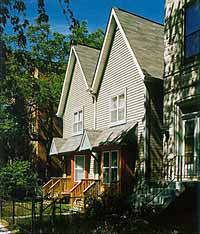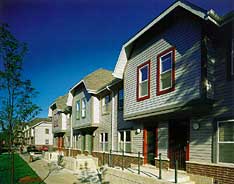|
|
Project Summary: International Homes
DEVELOPER
Voice of the People In Uptown, Inc.
ARCHITECT
Weese Langley Weese Architects Ltd.
CONTRACTOR
Thrush Construction, Inc.
| FUNDERS: | TYPE: |
| La Salle/Cragin Bank
| Grant |
| Federal Home Loan Bank | Grant |
| Illinois Dept. of Energy and N.R. | Grant |
| City of Chicago, Dept. of Hsg. | Grant |
| Uptown Nat'l Bank of Chicago | Loan |
| LISC | Predev. grant |
DEVELOPMENT TYPE:
New construction, scattered-site, for-sale attached townhouses.
RESIDENT PROFILE:
Low- and moderate-income first-time homebuyers.
DENSITY: 14 units per acre
DEVELOPMENT PROFILE
| Type | #/Units | Size (sf) | Rents |
| 3 BR | 28 | 1,200 | $72,000-80,000 |
| Total | 28 | | |
|
Parking: 28, surface
|
CONSTRUCTION TYPE
Two-story woodframe, concrete basements, vinyl and wood siding,
wood truss roofs and floors.
DEVELOPMENT COSTS:
Land cost: $103,832; Constr. costs: $2,240,000; Other costs: $334,168;
Total development costs: $2,678,000 ($95,642/unit ave.); Completed 1993-94.
|
|
|
INTERNATIONAL HOMES, Chicago, Illinois
 Planned and implemented in cooperation with neighborhood organizations, the International Homes offered the opportunity for home ownership at affordable prices to diverse groups of people. Located on vacant lots mostly owned by the city, the development has 28 attached rowhouses with 1200 square feet plus a full basement and a private outdoor space. Weese Langley Weese designed the buildings to blend with the traditional architecture and streetscape of Chicago's Uptown neighborhood. The homes are grouped together with high roofs to fit the scale of the high density neighborhood; gables and porches emphasize the individuality of the homes. Planned and implemented in cooperation with neighborhood organizations, the International Homes offered the opportunity for home ownership at affordable prices to diverse groups of people. Located on vacant lots mostly owned by the city, the development has 28 attached rowhouses with 1200 square feet plus a full basement and a private outdoor space. Weese Langley Weese designed the buildings to blend with the traditional architecture and streetscape of Chicago's Uptown neighborhood. The homes are grouped together with high roofs to fit the scale of the high density neighborhood; gables and porches emphasize the individuality of the homes.
 Voice of the People in Uptown, Inc., a nonprofit housing development corporation that has been active in the Uptown community for 25 years, conducted workshops to familiarize prospective buyers with the application and purchase process. The buyers reflected the racial and ethnic diversity of Uptown and included African, African-American, Asian, Hispanic, Middle Eastern, Native American, and Caucasian households. Buyers were able to purchase the houses with a minimal downpayment and must sell the houses to qualified families with low-incomes. The community gained both stability and vitality with the replacement of dangerous vacant lots with quality homes, without gentrifying the neighborhood. Voice of the People in Uptown, Inc., a nonprofit housing development corporation that has been active in the Uptown community for 25 years, conducted workshops to familiarize prospective buyers with the application and purchase process. The buyers reflected the racial and ethnic diversity of Uptown and included African, African-American, Asian, Hispanic, Middle Eastern, Native American, and Caucasian households. Buyers were able to purchase the houses with a minimal downpayment and must sell the houses to qualified families with low-incomes. The community gained both stability and vitality with the replacement of dangerous vacant lots with quality homes, without gentrifying the neighborhood.

|